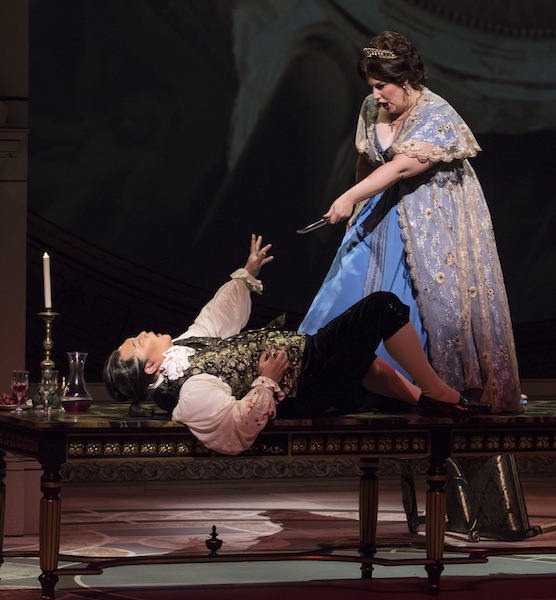Wolf Trap Opera serves up searing summer verismo with Puccini’s “Tosca”

Alexandra Loutsion in the title role and Kihun Yoon as Scarpia in Puccini’s “Tosca” at Wolf Trap Opera. Photo: Scott Suchman
Giacomo Puccini’s Tosca might not make most opera companies’ shortlists for light summer fare with its political backdrop and scenes of murder, torture and assault. However in Wolf Trap Opera’s case, the three-act tragedy not only made the cut–so to speak–but with a dedicated cast and orchestra did so in a searing, one-night-only performance Friday evening at the Filene Center.
As the feisty singer Floria Tosca, Alexandra Loutsion initially sounded a bit chesty in the lower register but her soprano blossomed as the opera progressed. She sang with apt coy playfulness as she teased her lover Cavaradossi, and fretted convincingly while beset by the twisted demands of Baron Scarpia. Loutsion rose to the challenge of “Vissi d’arte” with her finest vocal moments. Singing with fragile tone, the aria came across as prayerful and confessional and showcased the full depth of the soprano’s abilities.
As the painter Mario Cavaradossi, Mackenzie Gotcher performed with a lyrical but muscular tenor and often a gentle vibrato. He sang with conviction and emotional impact throughout and maintained a convincing and confident stage presence from the start. The breadth of Gotcher’s vocal talents was evident in his scenes with each of the cast members. Cavaradossi’s poignant aria “E lucevan le stelle,” when the tenor sang with a subdued voice and understated anguish, conveyed the full spectrum of his artistry.
Baritone Kihun Yoon made a commanding entrance as Scarpia, his rich baritone capturing the character’s evil complexity in his singing. He conveyed the deceptively gallant stance of the corrupt police chief, with a Scarpia less sinister than sneaky and conniving. Yoon managed to bark orders yet softly coo and snake his way around Tosca, his object of desire, in a way that was slimy yet consistently compelling.
Bass-baritone Richard Ollarsaba embraced his role as the prison escapee Angelotti, while Anthony Robin Schneider’s Sacristan was aptly comical and easily projected his voice.
Under the baton of guest conductor Grant Gershon, the National Symphony Orchestra played with zest from behind the sloping stage and backdrop of Roman columns and oversized picture frames. With the Washington Chorus and the Children’s Chorus of Washington in support, the instrumentalists kept the evening moving at a consistent clip. The amplification unfortunately buried Scarpia’s interrogation of Cavaradossi in Act II, but their faint introductory refrain of “E lucevan” in the third act set the scene perfectly for Cavaradossi’s key aria.
This new production offered some slightly modern touches. Director Louisa Muller preserved Puccini’s original Rome setting with simple set designs and tasteful costumes and stage props.
She also allowed her team to use video backdrops to enhance the production. When the video helped to set the scene or mood – swirling clouds, a starry night, a wall of classical paintings – it was effective. But when it was used as transitions or to advance the plot – picture frames turning red, altar boys walking up with candles, Tosca flying into the heavens – it served as more of a hokey distraction from the music and onstage action. In other Wolf Trap productions, including last summer’s La Boheme, the projections worked well but here too often seemed over the top.
The largely successful production was not without some staging hiccups – one of the video projectors blew out early on in the first act (and was promptly restored) and an LED candle toppled and rolled downstage and into the (fortunately empty) orchestra pit during the third act’s musical interlude.
Grace Jean has been covering classical music in the Washington, DC area since 2003. Her reviews have appeared in The Washington Post.



Posted Jul 16, 2017 at 4:46 pm by Mark D
My wife and I were a bit confused by the start of Act 3. The interlude with the children moving candles around the stage seemed odd to us. It felt like a placeholder rather than an integral part of the performance. Was the Shepard (Megan Mikailovna Samarin) unable to perform? We didn’t recall seeing her at the start of Act 3 as expected. Perhaps we missed it.